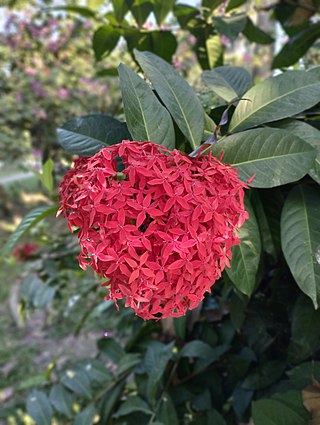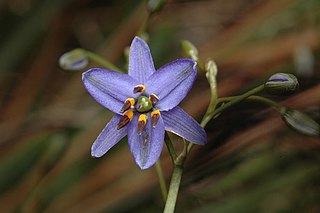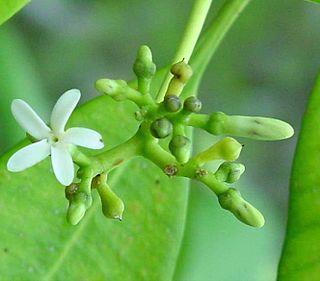
Ixora is a genus of flowering plants in the family Rubiaceae. It is the only genus in the tribe Ixoreae. It consists of tropical evergreen trees and shrubs and holds around 544 species. Though native to the tropical and subtropical areas throughout the world, its centre of diversity is in Tropical Asia. Ixora also grows commonly in subtropical climates in the United States, such as Florida where it is commonly known as West Indian jasmine.

Dianella is a genus of about forty species of flowering plants in the monocot family Asphodelaceae, commonly known as flax lilies. Plants in this genus are tufted herbs with more or less linear leaves and bisexual flowers with three sepals more or less similar to three petals and a superior ovary, the fruit a berry. They occur in Africa, South-east Asia, the Pacific Islands, New Zealand and Australia.

Geniostoma is a genus of around 49 species of flowering plants in the family Loganiaceae. They are shrubs or small trees, with inflorescences borne in the axils of the simple, petiolate, oppositely-arranged leaves. The flowers are arranged in cymes, and each is pentamerous.

Ochrosia brownii, synonym Neisosperma brownii, is a species of plant in the family Apocynaceae. It was endemic to the Marquesas Islands in French Polynesia and is extinct in the wild.

Myrsine is a genus of flowering plants in the family Primulaceae. It was formerly placed in the family Myrsinaceae before this was merged into the Primulaceae. It is found nearly worldwide, primarily in tropical and subtropical areas. It contains over 280 species, including several notable radiations, such as the matipo of New Zealand and the kōlea of Hawaiʻi. In the United States, members of this genus are known as colicwood. Some species, especially M. africana, are grown as ornamental shrubs.
Ulmus × hollandica var. insularum was recognized as a biometrically distinct population of U. × hollandica endemic to all the Channel Islands and the Cotentin Peninsula of France by Richens and Jeffers in 1975. As of January 2025, Plants of the World Online did not accept this or any other varieties of U. × hollandica, treating them all as synonyms of the hybrid species.
Lepturopetium is a genus of Pacific Island plants in the grass family.

Abelia chinensis, commonly known as Chinese abelia, is a species of flowering plant in the honeysuckle family Caprifoliaceae. It is a semi-evergreen, densely branched shrub with dark green foliage.

Phyllanthus maderaspatensis is a perennial herbaceous species of plant in the family Phyllanthaceae, widespread in tropical and subtropical areas of the old world, including tropical Africa, Madagascar and the western Indian Ocean Islands, the Arabian Peninsula, the Indian subcontinent, Indochina, southeastern China, Java, New Guinea, and northern and eastern Australia.

Elaeocarpus joga is a species of tree in the family Elaeocarpaceae. It is native to the Mariana Islands and Palau. It is a moderately-sized tree with blue-coloured, round, 1.5cm diameter fruit and leaves which turn bright red before they senescence.
Occurring as a shrub or as a tree, Daphniphyllum majus is a species in the family Daphniphyllaceae. It is found in Mainland Southeast Asia and Yunnan in China. Uses of the plant include fuel and smoking-material.
Cyperus appendiculatus is a species of sedge that is native to Brazil, Saint Helena, and Ascension Island.

Ixora biflora is a shrub in the family Rubiaceae growing up to 2 m high. It is endemic to northeastern Queensland, Australia, and inhabits the understorey of well developed rainforests. Its main range extends from the vicinity of Rossville to just south of Port Douglas, with isolated occurrences as far south as Mackay.
Psychotria hombroniana is shrub or tree in the family Rubiaceae that is endemic to the Caroline and Mariana Islands in the northwest Pacific Ocean.
Santalum insulare is a species of flowering plant in family Santalaceae. It is a shrub or tree native to the south-central Pacific, including the Cook Islands, Marquesas Islands, Pitcairn Islands, Society Islands, and Tubuai Islands.
Terminalia glabrata is a species of flowering plant in family Combretaceae. In the Cook Islands it is commonly known as eastern tropical-almond, kauariki, or ‘enua. It is a tree native to the Cook Islands, Marquesas Islands, Samoan Islands, Society Islands, Tuamotu Archipelago, and Tubuai Islands in the South Pacific.
Aidia racemosa is a tree in the Rubiaceae family, native from Thailand east to the Pacific islands and south to Australia.

Hedyotis scabridifolia is an herb or small shrub that is endemic to the volcanic soils of the Mariana Islands of Guam, Rota and Saipan.










